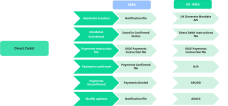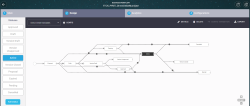Direct Debit
The Billing & Collection solution helps SEPA![]() Single Euro Payments Area allows customers to make cashless euro payments – via credit transfer and direct debit, to anywhere in the European Union. and UK insurers to handle direct debit payment operations, starting with the direct debit mandate activation procedure, in order to notify the bank about the payment arrangement between insurer and insured, up to the moment the payment is collected.
Single Euro Payments Area allows customers to make cashless euro payments – via credit transfer and direct debit, to anywhere in the European Union. and UK insurers to handle direct debit payment operations, starting with the direct debit mandate activation procedure, in order to notify the bank about the payment arrangement between insurer and insured, up to the moment the payment is collected.
The Billing & Collection direct debit functionalities can be applied to policies that have the payment type set to Direct Debit, and their business status is in InForce or Suspended. For those policies, the solution processes all the invoices that are in Generated business status, with their due date less or equal to the current date, added to the value set in the numberOfDaysInAdvance parameter. For every valid policy with direct debit payment that has an invoice generated according to its payment schedule, the solution generates a payment instructions file that informs the bank to operate the direct debit payment (charge the premium amount on behalf of the insurer).
For implementing a certain direct debit flow, you must choose its corresponding Direct Debit Type, either SEPA or UK. Learn how to set the solution for DIDE processing by accessing the Configure the Direct Debit Type page. The main steps for the SEPA and UK direct debit types are given below.
Direct Debit Business Workflow
FTOS_PYMT_DirectDebitMandate is the master business workflow that handles the different types of changes affecting a direct debit mandate during its lifetime, like transitioning the mandate through different versions and business states (from Draft to Expired). All the updates are logged in the mandate history tab, for further analytical use.
Below, an example of the FTOS_PYMT_DirectDebitMandate business workflow - as it is displayed on FintechOS Studio:
A direct debit mandate stage can take one of the following values:
-
N (New),
-
D (Deleted, Cancelled), or
-
M (Modified).
These stages are registered by the solution, following the processing of payment files/ payment data. For example, if a request for payment through an active mandate is denied, this is picked out and sorted by the system, and the mandate is transitioned to the Deleted stage. The system also automatically logs this update on the relevant mandate record (done by creating an actualized version of the mandate).
The following are the behaviors - characteristic to any mandate, managed by this business workflow:
-
Every mandate (or mandate version) starts in Draft status and must go through an approval process before reaching the Active status. Approval is automatic, based on bank response.
-
Once a mandate is in Active status, its settings can no longer be modified.
-
If you want to manually update an Active mandate, you must create a new mandate version. After editing, you must manually approve the new mandate version; use the status picker to pick the Approved status.
-
When you create a new mandate version, the current version is retired.
-
Only one version of a mandate can be live at one time.
-
Only one draft version can be active at one time. If the case, you must close the current draft version and then, open another one.
-
Mandates in Cancelled status cannot be edited (versioned) - by you or the system.
-
No mandate can be deleted manually from the system.
-
The system also can automatically adjust a mandate, based on mandate data received. All adjustments are automatically integrated into a new version of the mandate, and logged into the mandate history.
| Status name | Description |
|---|---|
| Proposal | Initial state for any mandate registered in the system. |
| Draft | Initial state for any mandate registered in the system. |
| Pending | Ongoing state - the mandate is pending approval from the bank. |
| Active | Ongoing state. |
| Version Draft | When the selected mandate becomes editable. |
| Version Unapproved | When a draft version of a mandate is canceled. |
| Approved | Ongoing state. |
| Version Closed | When a draft version of a mandate is closed. |
| Expired | Final state. The mandate is expired. The mandate cannot be moved from this state to any other states. |
| Cancelled | Final state. The mandate is cancelled. The mandate cannot be edited or moved from this state to any other states. |
| Transition | Description |
|---|---|
| _Proposal | Initial state. |
| Active_Cancelled | When the system registers a notification about the mandate cancellation. |
| Active_Expired | When the mandate reaches its end day. The expiration triggers the automatic change of the payment type on the policy, from Direct Debit to Bank Transfer (OP). |
| Active_VersionClosed | When a version of the mandate is closed. Used for mandate versioning. |
| Approved_Active | When the mandate reaches its start day. |
| Approved_Draft | When a change of the policy payment type from Bank Transfer (OP) into Direct Debit is performed on a policy. Also, when creating a new mandate version, this starts from the Draft version. |
| Approved_Expired | When the number of days for the activation of a mandate were exhausted. |
| Cancelled_Active | When a mandate is reactivated. This status is only visible/ available for DIDE UK processing. |
| Draft_Active | When the mandate reaches its start day. This transition is triggered automatically by a specific job that verifies if the current date is the mandate begin date and changes the status to Active for all eligible mandates. |
| Draft_Cancelled | When the system registers a notification about the mandate cancellation. |
| Draft_Expired | When the number of days for the activation of a mandate were exhausted. The expiration triggers the automatic change of the payment type on the policy, from Direct Debit to Bank Transfer (OP). |
| Draft_Pending | After the instruction file for the mandate's activation is generated, and the mandate is pending approval from the bank. |
| Draft_VersionDraft | When the mandate versioning process starts. |
| Pending_Active | When the mandate reaches its start day. |
| Pending_Cancelled | When the system registers a notification (e.g. AUDDIS |
| Proposal_Active | When the mandate reaches its start day. |
| Proposal_Draft | When the mandate is registered in the system but it is not activated yet, or its begin date is yet to come. |
| Proposal_Expired | When the number of days for the activation of a draft mandate were exhausted. |
| VersionDraft_Approved | When a version of the mandate is approved. Used for mandate versioning. |
| VersionDraft_VersionUnapproved | When the opened version is not approved. Used for mandate versioning. |

